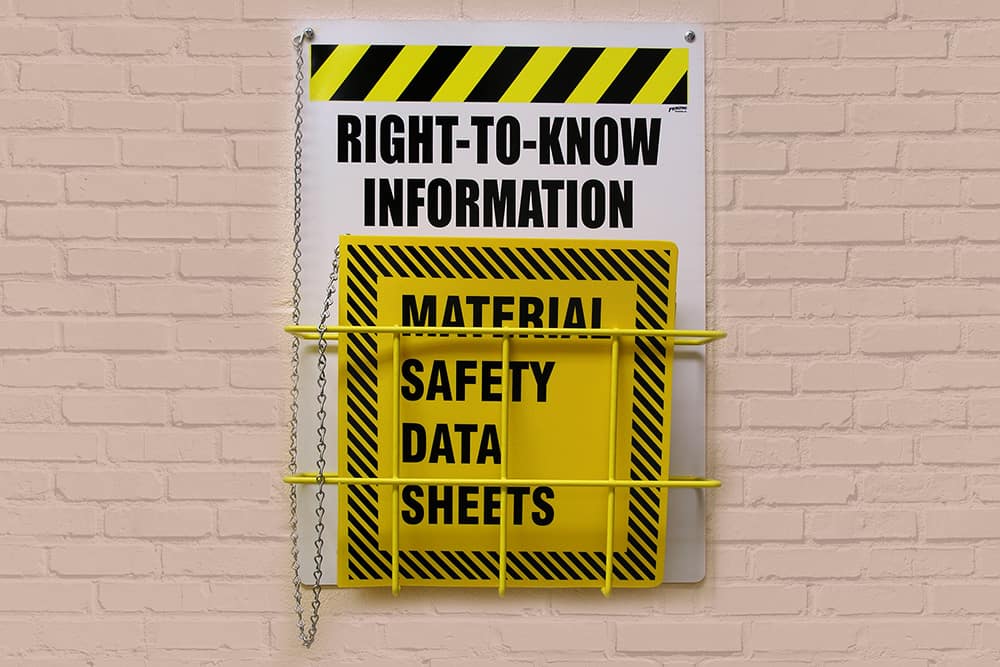
Any chemical, or substance, that’s hazardous and used in the workplace, must come with a safety data sheet. It is a document that provides essential information for people that work with hazardous substances. The details in a safety data sheet inform people on how to use and store the product.
Under the Control of Substances Hazardous to Health (COSHH) regulations, employers must provide all employees that work with hazardous substances with training, information, and instructions on how to do so. To comply with the legislation, employers and employees must know what should be on safety data sheets and why they are critical for workplace safety.
What is a Material Safety Data Sheet?
A safety data sheet (SDS), is also referred to as a material safety data sheet (MSDS) or a product safety data sheet (PSDS). However, these names are now generally considered outdated. SDSs are supplied by the manufacturer for any substances that are deemed hazardous, as per the UK Registration, Evaluation, Authorisation and Restriction of Chemicals Regulations (REACH)
They describe the properties, contents, and hazards of a chemical or mixture of chemicals. They also provide information on how to handle and store the chemical as well as details on what to do if an emergency incident occurs.
COSHH Training
Our COSHH Training course provides basic awareness to trainees to help them identify the dangers and adopt safe working practices whilst working with hazardous substances, as well as, comply with the law.
What Information Should Be on a Safety Data Sheet?
All safety data sheets must contain the following information:
- Identification of the substance or mixture
- Manufacturer name and contact details
- Hazards identification
- Composition information
- First-aid measures
- Fire-fighting measures
- Accidental release measures
- Handling information and instructions
- Storage information and instructions
- Exposure controls and limits
- Personal protection required, such as eye, face, skin, or respiratory protection
- Properties – both physical and chemical
- Stability properties of the chemical
- Reactivity properties of the chemical
- Toxicological information
- Ecological information
- Safe disposal methods
- How to transport the chemical
- Regulatory information applicable to the chemical
- Other pertinent information
The information must be prepared by a competent person and be translated into the language of the country where the chemical is sold.
Additional requirements:
- Legible
- Dated
- Numbered with page numbers
- Provided at no cost by the manufacturer
- Available at the time the first delivery is received
Other requirements include:
- Pictograms that meet the COSSH standards
- Hazard and precautionary statements
- The signal word must be relevant to the chemical*
*Signal words include the words “warning” or “danger” which should be written on the label
Safety data sheets can be produced as paper booklets or in digital formats.
If new information about the chemical becomes available, or changes to legislation occur, the safety data sheet must be updated. It must be sent to all businesses or individuals who have purchased the chemical within the previous 12 months. It is recommended that employers check with manufacturers at least once every 12 months to see if there have been any updates to the safety data sheets.
Do All Chemicals Require a Safety Data Sheet?
All chemicals that are provided by a manufacturer for use in a workplace setting must have a safety data sheet according to the UK REACH Regulations. The REACH Regulations state specifically that a safety data sheet must be supplied if a product fits the below conditions:
‘Where a substance or mixture meets the criteria for classification as hazardous in accordance with Regulation (EC) No 1272/2008; or where a substance is persistent, bioaccumulative and toxic or very persistent and very bioaccumulative in accordance with the criteria set out in Annex XIII; or where a substance is included in the list established in accordance with Article 59(1) for reasons other than those referred to in points (a) and (b).’
Note that any hazardous substances or mixtures sold or offered to the general public do not require safety data sheets. These products must have ‘sufficient information to enable users to take the necessary measures as regards the protection of human health, safety and the environment, unless requested by a downstream user or distributor’, according to the REACH Regulations. However, a safety data sheet must still be supplied if the product is to be used in the workplace.
Any hazardous substances produced as a result of work activities will not have safety data sheets. These substances must be controlled in accordance with the instructions provided by the manufacturer of the substances used, or by guidelines given by the Health and Safety Executive (HSE).
What If the Safety Data Sheet is Lost or Not Attached to the Substance?
If you lose a safety data sheet or it’s damaged and no longer legible, the best course of action is to contact the supplier or manufacturer directly, and ask for a replacement.
If a product does not have a safety data sheet attached, and the supplier or manufacturer cannot be reached, you may be able to find information about the substance online or via the HSE. It’s recommended that you alert the HSE to the fact that a particular product was not supplied with a safety data sheet.
How to Use a Safety Data Sheet
The information on the safety data sheet explains the safe use of the chemical but does NOT contain details on controls specific to any one workplace. Safety data sheets assist with, but do not replace, risk assessments. The information contained in an SDS should help the person making the risk assessment to decide what control measures to take, to protect workers and the public.
COSHH requires employers to provide their employees with information, instruction, and training, relevant to the hazardous substances they use. The information contained in safety data sheets can play an important role in this process.

Employers should be aware that it’s not enough to just rely on a safety data sheet to meet the COSHH standards. Workplace controls, procedures and safe systems of work must still be explained to employees. If they ask to see them, employees must be given access to all safety data sheets that apply to the chemicals used in the workplace.
How to Comply with Hazardous Substances Legislation
All employees should be aware of the importance of safety data sheets. However, as mentioned, it’s not enough for employers to only provide access to safety data sheets. To be compliant with UK health and safety legislation, employers must provide their employees with relevant health and safety training. The Human Focus Hazardous Substances courses teach participants how to handle and control hazardous substances safely.
The Hazardous Substances training course covers a broad range of topics that are invaluable to anyone who works with them. Trainees can complete the courses online in segments, at their convenience. All Human Focus courses are recognised by a variety of industries and approved by authorities such as the Royal Society of Chemistry.
Make sure that your workplace is a safe place to work!






















